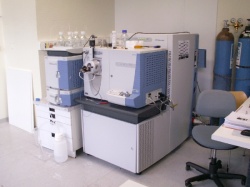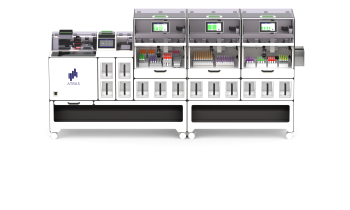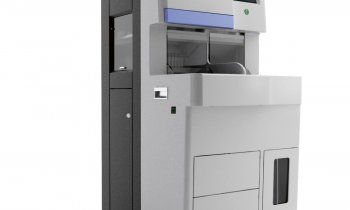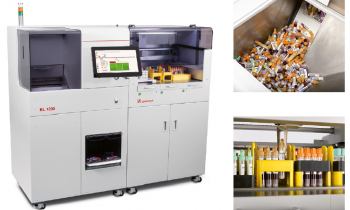The future of mass spectrometry in laboratory medicine
Karoline Laarmann reports
The world consists of molecules – so do we. With the progression of measurement tools such as microscopes, centrifuges, or spectrometers, mankind is becoming better and better in identifying the substances from which our world is made. Today, with the technical developments in mass spectrometry, biomolecules can be weighted with the highest precision and accuracy ever known, placing it among the booming analytic technologies conquering the field of clinical chemistry, microbiology and toxicology, says Prof Dr Denis Hochstrasser, Chairman of the Genetic and Laboratory Medicine Department of the Geneva University Hospital, Switzerland.


Until now it has only been possible to measure the properties of molecules in time-consuming, expensive and often less specific laboratory procedures. With high-performance mass spectrometry the molecular mass itself can be measured (mass-to-charge-ratio) with a breath-taking speed and sensitivity in nominal concentrations, which makes it extremely helpful in drug detection, e.g. to monitor therapeutic drugs, as well as to analyse non-specific samples.
However, mass spec had to undergo some significant technical developments before it became performable in clinical practice -- it had to become more precise, much faster, and much simpler explained Dr Hochstrasser. ‘Mass spec consists of three steps: ion creation, ion separation and ion detection. In the past, to prepare the family of molecules in the chromatograph (ion creation) before mass spec, it took a highly trained person. With the automation of the technology, any lab technician can now do it with a press of a button.’
Many different instrument types are available for this. Until recently, gas chromatography mass spec (GCMS) was the most common, as it is easy to use and has excellent databases available. The downside? As the name ‘gas chromatography’ implies, blood samples have to be volatiled first. Recently, therefore, the major progress in mass spec has been in liquid chromatography mass spec (LCMS), where the fluid samples no longer need to be derivatised and extracted.
Electron ionisation
There are two main streams in LCMS to prepare the ion for the mass spec: matrix-assisted laser desorption/ionisation (MALDI) and electrospray ionisation (ESI).
With MALDI, the test sample is put on a target together with a matrix in the form of a weak organic acid. A laser beam is then shot on the target and the H+ proton of the matrix jumps on the sample. The now positive charged sample is then vaporised by the laser energy and can enter the mass spec.
By contrast, with ESI a fine metal needle is placed at the end of a tube. The needle is then charged with electricity. Next, when the fluid sample is pushed through the tube it comes out as a very fine aerosol – as if blown through a drinking straw. The droplets are now charged with high electric voltage from the needle. If they enter the mass spec, the highly charged droplets dry and evaporate. What remains are positive charged ions.
From flying to tandem
The next step is to separate and detect the ions in the mass spec. For this, various technologies are also used. A powerful technique, called MALDI-TOF-MS (Matrix-Assisted-Laser-Desorption/Ionisation –Time-Of-Flight-Mass-Spectrometry), is mostly used in microbiology for the classification of micro-organisms, such as pathogens and fungus.
The ions are accelerated in an electric field and conducted through a flight tube. A detector then measures their time of flight: small molecules fly fast; if big they fly slowly. ‘The precision with which we can measure the atomic mass unit in MALDI-TOF-MS is as precise as the Dalton scale,’ Prof. Hochstrasser points out. ‘The identification of samples takes seconds, which means you can save between eight hours and four days with MALDI-TOF-MS, because it is no longer necessary to grow colonies of bacteria to classify them. That’s why the technology is really booming. It is available in the moment by only two companies, Bruker and Shimadzu.’
MSMS (tandem mass spectrometry) is another method -- most popular in toxicology. Nowadays, MSMS is moving from gas chromatography to liquid chromatography. Instead of only one, there are up to three mass analysers involved: The first quadripole measures the size of the molecules, the second breaks them into pieces, and the third measures the size of the fragments. The sizes of what is called the parent ion and of the fragments are then identified in a database.
Costs
For the clinical laboratory, the acquisition of a mass spectrometer is a major investment. The instruments can cost between €50,000 and €100,000 up to €1 million. Nevertheless, the systems have proliferated in the lab market. ‘A mass spectrometer is costly to buy, but low-priced in usage. The difference to other methods, such as immunoassays, is that you don’t need any reagents’, Dr Hochstrasser points out.
As to the future of mass spec, he believes it might be possible even to identify cancer cells in biopsy with this exciting technique. Experimental studies in this new field are already running.
* On 19 May, 2011, at the IFCC-WorldLab Congress in Berlin, Prof. Dr Denis Hochstrasser will speak about ‘Mass Spectrometry: its future in several disciplines of laboratory medicine’.
Details: www.berlin2011.org
29.12.2010











